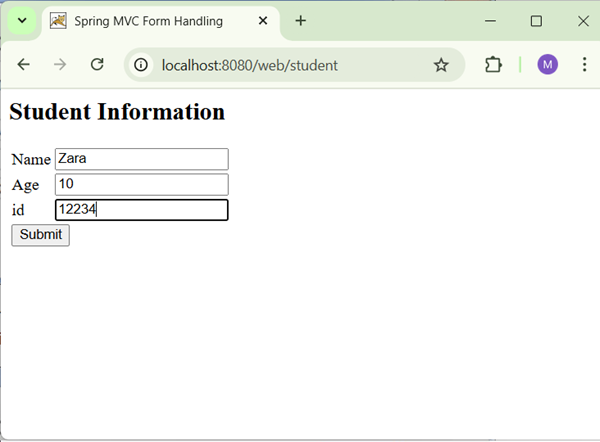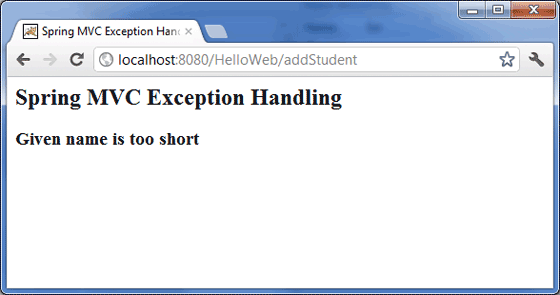
- Spring - Home
- Spring - Overview
- Spring - Architecture
- Spring - Environment Setup
- Spring - Hello World Example
- Spring - IoC Containers
- Spring - Bean Definition
- Spring - Bean Scopes
- Spring - Bean Life Cycle
- Spring - Bean Post Processors
- Spring - Bean Definition Inheritance
- Spring - Dependency Injection
- Spring - Injecting Inner Beans
- Spring - Injecting Collection
- Spring - Beans Auto-Wiring
- Annotation Based Configuration
- Spring - Java Based Configuration
- Spring - Event Handling in Spring
- Spring - Custom Events in Spring
- Spring - AOP with Spring Framework
- Spring - JDBC Framework
- Spring - Transaction Management
- Spring - Web MVC Framework
- Spring - Logging with Log4J
Spring Useful Resources
Spring - Exception Handling Example
The following example shows how to write a simple web-based application using Spring MVC Framework, which can handle one or more exceptions raised inside its controllers. To start with, let us have a working Eclipse IDE in place and take the following steps to develop a Dynamic Form based Web Application using Spring Web Framework −
Example - Exception Handling
| Steps | Description |
|---|---|
| 1 | Create a Maven project with archetype as maven-archetype-webapp with a name web, groupid com.tutorialspoint, artifactid web and create a package com.tutorialspoint under the src folder in the created project. |
| 2 | Update the pom.xml as explained in the Spring - MVC Hello World Example chapter. |
| 3 | Create a Java class Student,StudentController and SpringException, under the com.tutorialspoint package. |
| 4 | Create Spring configuration files web.xml and web-servlet.xml under the WEB-INF folder as explained in the Spring - MVC Hello World Example chapter. |
| 5 | Create a sub-folder with a name jsp under the WEB-INF folder. Create a view files student.jsp,result.jsp, error.jsp, and ExceptionPage.jsp under this sub-folder. |
| 6 | The final step is to create the content of all the source and configuration files and export the application as explained below. |
Student.java
package com.tutorialspoint;
public class Student {
private Integer age;
private String name;
private Integer id;
public void setAge(Integer age) {
this.age = age;
}
public Integer getAge() {
return age;
}
public void setName(String name) {
this.name = name;
}
public String getName() {
return name;
}
public void setId(Integer id) {
this.id = id;
}
public Integer getId() {
return id;
}
}
SpringException.java
package com.tutorialspoint;
public class SpringException extends RuntimeException{
private String exceptionMsg;
public SpringException(String exceptionMsg) {
this.exceptionMsg = exceptionMsg;
}
public String getExceptionMsg(){
return this.exceptionMsg;
}
public void setExceptionMsg(String exceptionMsg) {
this.exceptionMsg = exceptionMsg;
}
}
StudentController.java
Following is the content of StudentController.java file. Here, you need to annotate a service method using @ExceptionHandler where you can specify one or more exceptions to be handled. If you are specifying more than one exception then you can use comma separated values.
package com.tutorialspoint;
import org.springframework.stereotype.Controller;
import org.springframework.web.bind.annotation.ExceptionHandler;
import org.springframework.web.bind.annotation.ModelAttribute;
import org.springframework.web.bind.annotation.RequestMapping;
import org.springframework.web.bind.annotation.RequestMethod;
import org.springframework.web.servlet.ModelAndView;
import org.springframework.ui.ModelMap;
@Controller
public class StudentController {
@RequestMapping(value = "/student", method = RequestMethod.GET)
public ModelAndView student() {
return new ModelAndView("student", "command", new Student());
}
@RequestMapping(value = "/addStudent", method = RequestMethod.POST)
@ExceptionHandler({SpringException.class})
public String addStudent( @ModelAttribute("HelloWeb")Student student,
ModelMap model) {
if(student.getName().length() < 5 ){
throw new SpringException("Given name is too short");
} else {
model.addAttribute("name", student.getName());
}
if( student.getAge() < 10 ){
throw new SpringException("Given age is too low");
} else {
model.addAttribute("age", student.getAge());
}
model.addAttribute("id", student.getId());
return "result";
}
}
web-servlet.xml
Following is the content of another Spring Web configuration file web-servlet.xml
<beans xmlns = "http://www.springframework.org/schema/beans"
xmlns:context = "http://www.springframework.org/schema/context"
xmlns:xsi = "http://www.w3.org/2001/XMLSchema-instance"
xsi:schemaLocation = "http://www.springframework.org/schema/beans
http://www.springframework.org/schema/beans/spring-beans-3.0.xsd
http://www.springframework.org/schema/context
http://www.springframework.org/schema/context/spring-context-3.0.xsd">
<context:component-scan base-package = "com.tutorialspoint" />
<bean class = "org.springframework.web.servlet.view.InternalResourceViewResolver">
<property name = "prefix" value = "/WEB-INF/jsp/" />
<property name = "suffix" value = ".jsp" />
</bean>
<bean class = "org.springframework.web.servlet.handler.SimpleMappingExceptionResolver">
<property name = "exceptionMappings">
<props>
<prop key = "com.tutorialspoint.SpringException">
ExceptionPage
</prop>
</props>
</property>
<property name = "defaultErrorView" value = "error"/>
</bean>
</beans>
Here you specified ExceptionPage as an exception view in case SpringException occurs, if there is any other type of exception then a generic view error will take place.
student.jsp
<%@taglib uri = "http://www.springframework.org/tags/form" prefix = "form"%>
<html>
<head>
<title>Spring MVC Exception Handling</title>
</head>
<body>
<h2>Student Information</h2>
<form:form method = "POST" action = "/web/addStudent">
<table>
<tr>
<td><form:label path = "name">Name</form:label></td>
<td><form:input path = "name" /></td>
</tr>
<tr>
<td><form:label path = "age">Age</form:label></td>
<td><form:input path = "age" /></td>
</tr>
<tr>
<td><form:label path = "id">id</form:label></td>
<td><form:input path = "id" /></td>
</tr>
<tr>
<td colspan = "2"><input type = "submit" value = "Submit"/></td>
</tr>
</table>
</form:form>
</body>
</html>
error.jsp
<html>
<head>
<title>Spring Error Page</title>
</head>
<body>
<p>An error occured, please contact webmaster.</p>
</body>
</html>
ExceptionPage.jsp
Following is the content of Spring view file ExceptionPage.jsp. Here you will access the exception instance via ${exception}.
<%@taglib uri = "http://www.springframework.org/tags/form" prefix = "form"%>
<html>
<head>
<title>Spring MVC Exception Handling</title>
</head>
<body>
<h2>Spring MVC Exception Handling</h2>
<h3>${exception.exceptionMsg}</h3>
</body>
</html>
result.jsp
<%@taglib uri = "http://www.springframework.org/tags/form" prefix = "form"%>
<html>
<head>
<title>Spring MVC Form Handling</title>
</head>
<body>
<h2>Submitted Student Information</h2>
<table>
<tr>
<td>Name</td>
<td>${name}</td>
</tr>
<tr>
<td>Age</td>
<td>${age}</td>
</tr>
<tr>
<td>ID</td>
<td>${id}</td>
</tr>
</table>
</body>
</html>
Output
Once you are done creating the source and configuration files, export your application. Right-click on your application and use run as > maven install > option and save your web.war file in Tomcat's webapps folder.
Now start your Tomcat server and make sure you are able to access other web pages from webapps folder using a standard browser. Now try to access the URL http://localhost:8080/web/student. If everything is fine with your Spring Web Applicationand, you should see the following result.

Enter the values as shown above and click the Submit buttom. If everything is fine with your Spring Web Application, you should see the following result.
